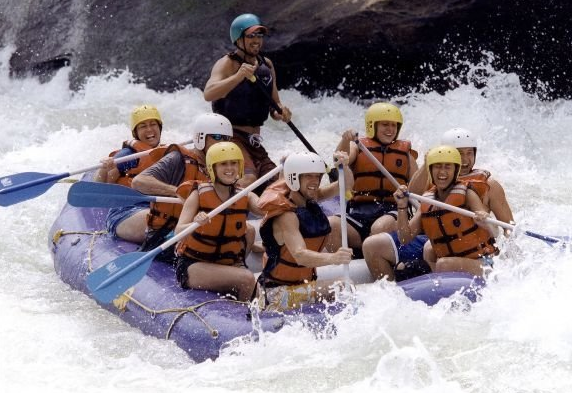What You Need to Know: 5 Beginner Whitewater Rafting Tips
May 1, 2013So you’re grabbing a paddle and heading out to take on the raging river rapids? Lucky you!
First timer? No worries! Here’s what you need to know before you go:
Shade from the Sun
Bring some sunscreen. Even if the sun isn’t blazing through the clouds in the morning, it might peek out as the day drags on. And even when they don’t seem harsh, the sun’s rays can still burn your skin if you’re out for a full day of rafting.
Brace Yourself in the Raft
Unless you’re looking for a swim, keep yourself planted firmly in the boat. You will have 3 main points of balance:
• Feet– keep your front foot tucked lightly under the air tube in front of you, or in the foot hold if you’re in the front of the raft. But don’t shove them in too far, because if you do fall out, you don’t want your foot to be trapped.
• Seat– Stay on the outer rim of the boat for the best balance, unless your guide instructs you to get down.
• Paddle– Believe it or not, sticking your paddle in the water provides an extra bracing point. So when the waves get harder, paddling harder will help keep them from tossing you into the rapids.
Be Swim-Ready
Even with the best bracing, you might find yourself in the water. Your guide will tell you before you even reach the rapid which way you’ll want to swim if you fall out too far from the raft. Once you’re in the water, orient yourself and look for your guide’s cues. He or she won’t steer you into danger.
Swim hard if you can, and if you aren’t a strong swimmer or can’t swim, let your guide know before you start. Most importantly: ALWAYS keep your feet up, because you can easily get them trapped by a rock along the river bed.
While you’re riding the river, be sure to regularly tighten your PFD (personal flotation device. Sometimes called a “life jacket,” but that can be misleading, because it isn’t always a sure-fire safety measure.) The water can loosen your straps, so just give them a tug every once in a while.
Paddle Together, Not Harder
In a raft of 8 or more paddlers, you alone can’t make it move. You want to pull strong paddle strokes, but half a boat stroking hard won’t be nearly as effective as a team of 8 working smoothly in unison. Front rafters: watch each other to stay in sync. Everyone behind: follow their lead.
Listen Up
It sounds like a no-brainer, but your guide knows what he or she is doing, so stay alert and listen to the commands. Missing a single paddle stroke in the middle of a rapid can mean the difference in barreling through a wave or being thrown over by it. Chat and enjoy your time on the river, but keep an ear open for any instructions as you go.
After you’ve tackled the rapids, let us know your tips for other new rafters!

